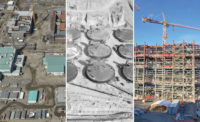ENR 2022 Top 25 Newsmakers
Valerie McCain: Bechtel Senior Executive Steers Nuclear Waste Cleanup Megaproject

Valerie McCain, (right), as project director of the federal Hanford nuclear site waste treatment complex in Washington state, led a public-private team that has completed its first facilities and started the test process for one of two 300-ton melters that will turn low-level radioactive waste into glass for burial
Photo: Bechtel National Inc.
Related Article:
New $130M Hanford Site Facility Is Start of Major Nuclear Waste Cleanup
Back to:
25 Top Newsmakers
There was “no turning back,” said one media report last October, for the public-private cleanup team on the U.S. Energy Dept.’s Hanford nuclear waste site’s epic vitrification plant project when the world’s largest melter—one of two 300-ton installed machines set to use 2,100° F of heat to convert waste into inert glass—was turned on for the first time.
It was a milestone for the 20-plus-year effort by Bechtel National Inc. as design, construction and commissioning contractor for the first industrial-scale process to dispose of 56 million gallons of radioactive and chemical waste dating to World War II stored at the one-time nuclear bombmaking complex in Washington state.
Valerie McCain, project director since 2018 and a Bechtel senior vice president, who died suddenly on March 26, had supervised completion and testing of the one-of-a-kind multi-structure project—building on years of development by a now 2,200-person team from the company, subcontractors and site partners, as well as DOE and other federal and state agencies to tackle the court-mandated cleanup of a site described as the most radioactively and chemically toxic spot in the Western Hemisphere.
McCain joined Bechtel in 1990, starting as an environmental scientist and cost engineer, and managed projects such as DOE’s giant uranium processing facility in Oak Ridge, Tenn., and the multibillion-dollar upgrade of a 60-year-old Canadian aluminum smelter.


Photos: Bechtel National Inc.
The Hanford plant complex has not been without controversy and cost—an estimated $17 billion to date—with technical challenges and shifts in direction, and more to come.
Too-rapid heatup forced halt of the melter test last year, with Bechtel and DOE now resolving issues before a test restart that is set for mid-year. The delay could push the start of treatment of millions of gallons of low-level radioactive waste to early 2024, but site officials said recently they would still meet a COVID-extended 2025 deadline.
“We know unanticipated issues will arise when we do things that have never been done before at this scale and complexity,” McCain said. “I am proud of the team’s resolve and determination in addressing challenges and advancing the mission.”
McCain’s leadership style revolved around “her ability to analyze data associated with a project this size and determine what issues are critically important, develop plans to address them and drive the team to implement those plans,” says Brian Reilly, also a Bechtel executive and a former plant project director.
McCain also had focused on facilities to pretreat and move Hanford waste to the plant and to manage still unclear future treatment of even more toxic material. Barbara Rusinko, just retired Bechtel nuclear unit president noted "no pretense with Val," describing her as a "genuine leader," respected for her "honesty and integrity."






